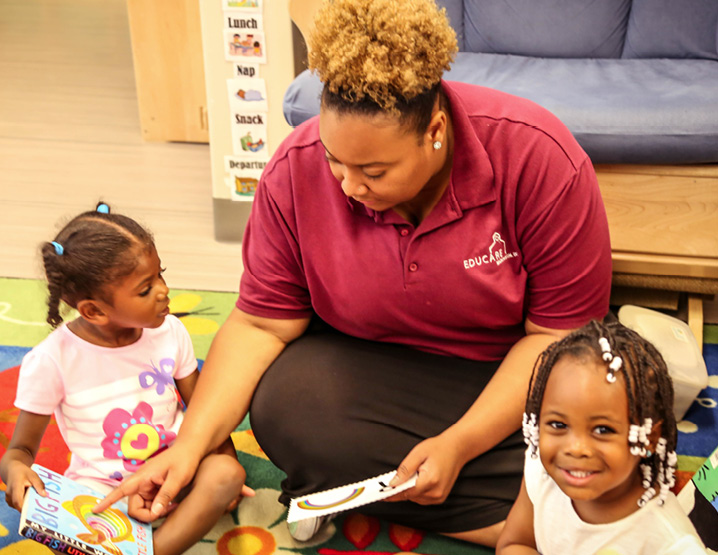"The hardest part of my job is understanding how to support the staff. As a teacher, I know about children and families, but I had to take some courses about adult learning and motivation. My coach was a great help, too." – Disability services coordinator
This chapter focuses on identifying and addressing your own learning needs. Your job as a disability services coordinator is wide-reaching, touching all aspects of the Head Start program. Your work with program staff, community partners, families, and children with disabilities requires a rich skill set. To ensure your program has a coordinated approach in place, you must attend to your own professional development.
Key Ideas
- It is essential that you access resources and training to support your professional growth.
- Working with a mentor is often a successful strategy.
- There are many multimedia options for networking and training.
- As you engage in professional development, you are setting a model for other staff.
- Make a professional development plan for yourself to explore any cultural biases or stereotypes that you bring to your job.
What is the training and professional development system in Head Start programs?
The HSPPS at 45 CFR §1302 Subpart I – Human Resources Management provide requirements about staff qualifications and competency. For children and family services staff, including those working in health and disabilities, training needs to build their knowledge, experience, and competence to improve child and family outcomes. A program must ensure staff who manage services to children with disabilities and who were hired after Nov. 7, 2016, have—at a minimum—a baccalaureate degree, preferably related to one or more of the disciplines they oversee. Disability services coordinators who also serve as education managers or coordinators must meet the degree requirements for those positions. Grantees have the option to implement more stringent staff qualifications than those in the HSPPS.
Many of the HSPPS requirements about training and professional development apply to all staff, including you. All staff must complete a minimum of 15 clock hours of professional development per year. As appropriate, the professional development should offer academic credit. 45 CFR §1302 Subpart J – Program Management and Quality Improvement requires programs have a coordinated approach for professional development to ensure high-quality services. This requirement supports a coordinated approach for children with disabilities and their families.
HSPPS Related to Training and Professional Development
Planning for Partnerships
Professional development is ongoing and multifaceted. As you develop your own professional development plans:
- Include joint training opportunities to ensure you and partners have consistent information
- Develop tools and protocols to help identify areas where you need to extend your knowledge and skills
- Create partnerships that offer courses and training for credit
- Investigate the opportunities they offer for your own career development
- Engage with other professionals in the disability services field so you can exchange ideas and learn from each other
Building Your Own Support Network
As the disability services coordinator, you are at the center of a coordinated approach to disability services. That means you connect with multiple systems and services in the program and community.
It may seem that your job never ends, that it's all-encompassing, and that it has many moving parts—and you're right! That's why you need to gather support from others in your program and your community. With technology, you also can reach across your state and the country. You can get advice, find new strategies, and network with others who understand just how demanding your job is.
Connecting with like-minded people and accessing resources can help you do your job better. OHS provides a virtual learning network hosted on the MyPeers platform. There are more than 40 communities to meet Head Start roles and interests, including the Disabilities/Inclusion Network. You can pose questions, problem-solve, share your successes, and find support for the challenges of your job. You are not alone!
Questions posted on MyPeers are wide ranging: What forms do you use to track the screening and referral process? What procedures do you have when a service dog has been assigned to a child? Do you have a job description for a coordinator? Register now as a member of MyPeers. If you are already a member, find the Head Start Disabilities/Inclusion Network under "All Communities" and select the blue "Join" button.
Creating Your Own Professional Development Plan
As you plan your own professional development, consider the variety of tasks you perform. Some are tied into areas of service (e.g., education, transportation, health, transitions). Do you feel confident about your knowledge base in these areas? Are you well-grounded in IDEA and the HSPPS? Much of your work involves collaborating with others, including program staff, community partners, and families. Are some interpersonal relationships easier than others? Do you know why? If you supervise other staff, how well do you meet those responsibilities? How do staff rate your supervisory skills? Where do you need to improve your supervision skills?
Professional growth is a must for all staff! You need to keep your curiosity alive and experience the joy of learning.
Ask yourself, "What are my priorities for professional growth this year?" If you did a recent self-assessment, that's a starting point. Maybe your last performance review identified both strengths and areas to improve. In looking over your performance reviews for the past several years, can you identify trends?
Take your data and reflect on your work. Then, begin to take these steps:
- Select a goal that is realistic and doable
- Consider the specific skills associated with that goal
- Develop an action plan
- Specify what you already know. What do you need to know?
- Identify what resources or support you need and draft a timeline
- Consider how achieving the goal will support your work as a disability services coordinator. Think about the measurable outcomes and the more intangible ones, such as your increased confidence or self-esteem
Identifying what you need to know may be a challenge. Turn to colleagues in your program, a mentor, coach, network peers, early intervention and special education partners, or T/TA providers to help you pinpoint areas of learning. Think about what you want to know and how to get there. Consider whether you want to accumulate credits for your professional development activities. Do you want to work toward an advanced degree? Take advantage of early childhood and early intervention and special education resources.
As you engage in your own professional development activities, your job description may need to be updated to reflect what you do. Do you need to add or modify roles and responsibilities? Work with your supervisor and the HR staff to revise your job description. Also, make sure to update your records to include recent coursework and credits.
Tips to Support Your Own Professional Development
- Identify support in your program. Build positive relationships with your program director and management staff.
- Take advantage of technology. Participate in professional development opportunities on your own time and at your own pace using web-based resources, such as the Individualized Professional Development (iPD) Portfolio or Early Educator Central.
- Find a mentor. Look for someone who has done well at a job like yours. A mentor is someone you can lean on and someone to celebrate your successes.
- Be a mentor. Strengthen your own knowledge and skills by mentoring another disability services coordinator.
- Participate in networking opportunities. Join the Head Start Disabilities/Inclusion Network on MyPeers. Look for other communities of learners.
 Connect with T/TA providers. They can offer direct support as you plan, implement, and evaluate disability services in your program. Your program director can contact the Regional Office to request assistance and also contact local experts.
Connect with T/TA providers. They can offer direct support as you plan, implement, and evaluate disability services in your program. Your program director can contact the Regional Office to request assistance and also contact local experts.- Join associations and professional organizations. State and local chapters often provide training, networking opportunities, and other resources focusing on disabilities and inclusion.
- Council for Exceptional Children
- NHSA
- NAEYC
- Child care resource and referral organizations
People to Help You
- Program management
- HR staff
- Mental health consultant
- Higher education faculty
- Special educators and early intervention providers
- T/TA providers
- Other disability services coordinators
Questions to Ask Yourself
- What do I do well?
- Where do I need to grow?
- Does my job description fit what I do? Does it need to be changed?
- Where do I want to be in my professional career in one year? Three years? Five years?
- Are there colleagues who will help me think through these questions?
Scenario
 Carla recently began working as a disability services coordinator for Community Action Head Start. She is excited to build on her experiences as a Head Start teacher and to be able to help a larger number of children and families. After a few days of reading through the HSPPS and policy manuals developed by her predecessor, Carla becomes concerned. She thinks to herself, "There is so much that I don't know! How can I ever be helpful to the teachers out there who know as much as I do?"
Carla recently began working as a disability services coordinator for Community Action Head Start. She is excited to build on her experiences as a Head Start teacher and to be able to help a larger number of children and families. After a few days of reading through the HSPPS and policy manuals developed by her predecessor, Carla becomes concerned. She thinks to herself, "There is so much that I don't know! How can I ever be helpful to the teachers out there who know as much as I do?"
During her weekly supervision meeting, Carla shares her concerns with the program director, Alicia. Together, they brainstorm the questions at the heart of Carla's concerns.
- What are my strengths?
- What can I share from my own experiences as a classroom teacher and the lessons I learned when supporting children with disabilities?
- What components of the job feel overwhelming to me? Where are my knowledge gaps?
- What aspects of inclusion am I most curious about? Which topics do I want to explore professionally?
- Where can I go to find this information? Are there books on these topics? Articles in journals or on websites? Professional development opportunities and conferences? Other team members who have information and success stories to share?
Using the answers to these questions, Carla identifies many lessons learned that she can share with team members right away. She also identifies her most pressing knowledge gaps and decides to explore three content areas in depth during the coming year: embedded learning opportunities, strategies to support the social and emotional needs of infants and toddlers, and development of an updated interagency MOU.
Alicia reminds Carla that learning a new job takes time. Together, they organize the three topics into a plan with a timeline Carla can manage along with her day-to-day responsibilities. Alicia also suggests that Carla reach out to Juan, the mental health consultant, to ask whether he would be willing to meet on a regular basis for a while. This would give Carla an opportunity to bounce ideas around with a peer. Carla thinks that is a great idea.
At the end of the meeting, Carla gives Alicia a hug and shares that the process really has lifted a load off of her shoulders. Even though she still has a lot to learn in her new role, Carla realizes she also has a lot to share with others. She knows the learning curve will present a great opportunity for personal and professional growth. She's excited and eager to dive into her work as a disability services coordinator!
Read more:
Resource Type: Article
National Centers: Early Childhood Development, Teaching and Learning
Last Updated: December 9, 2022